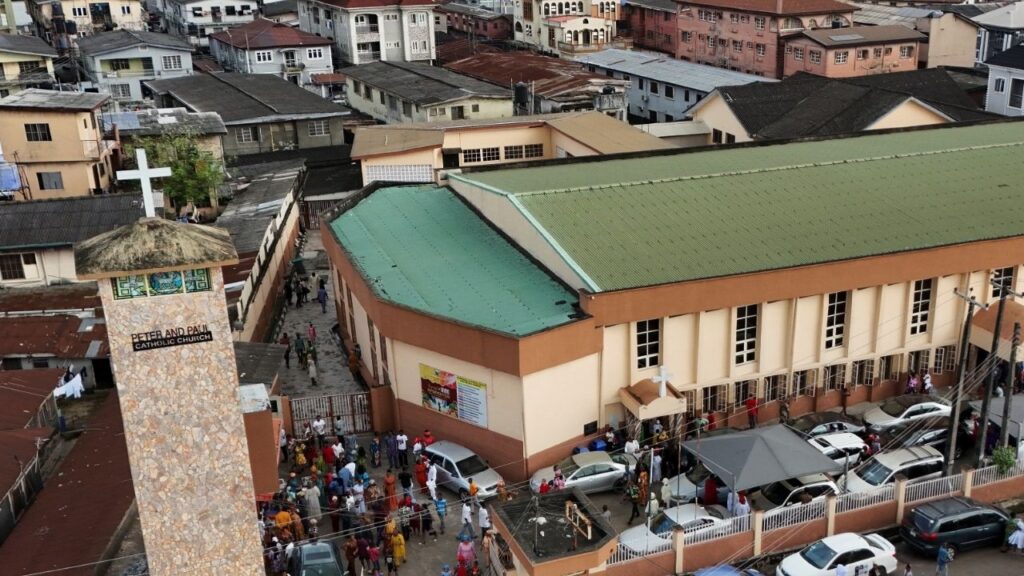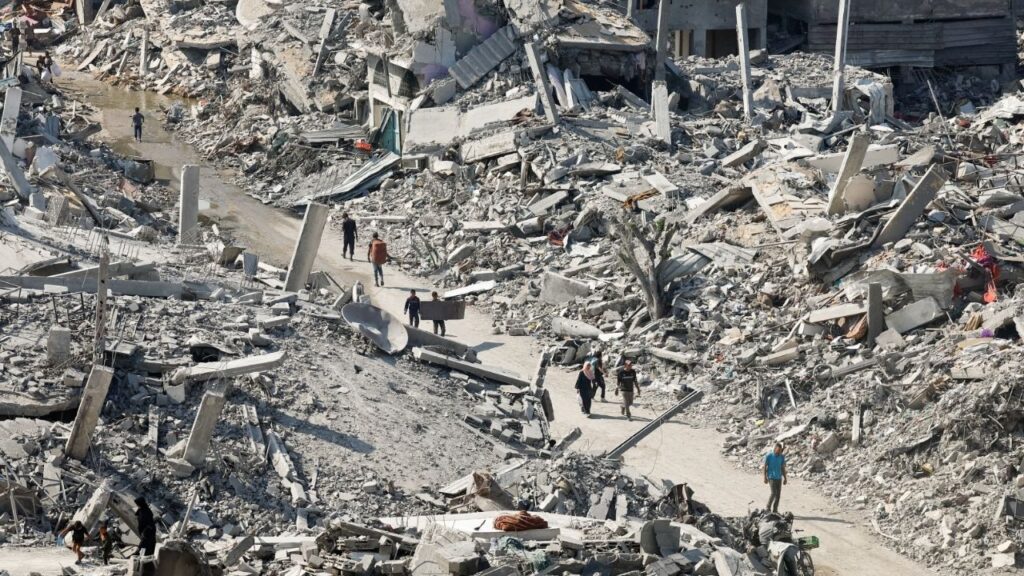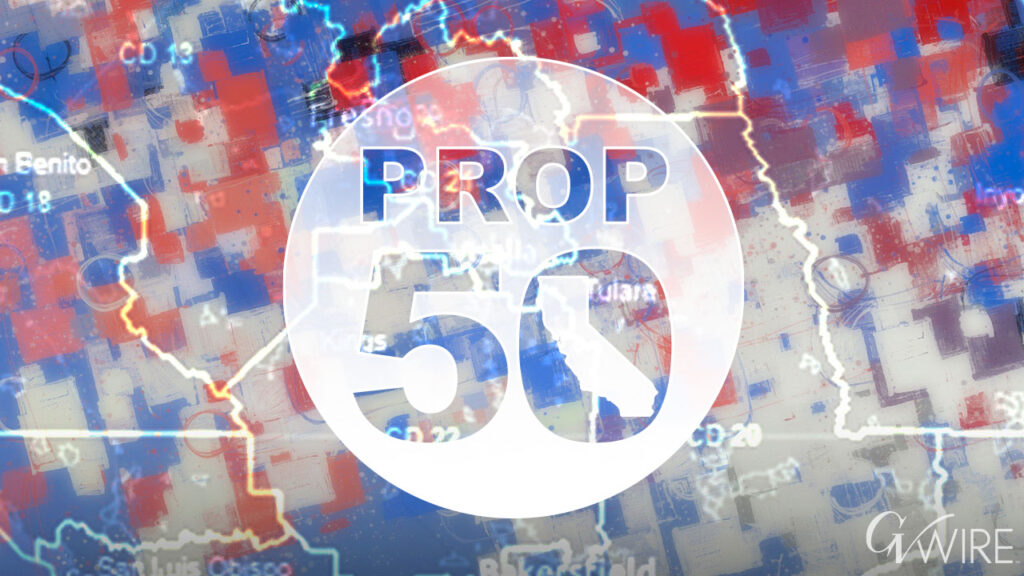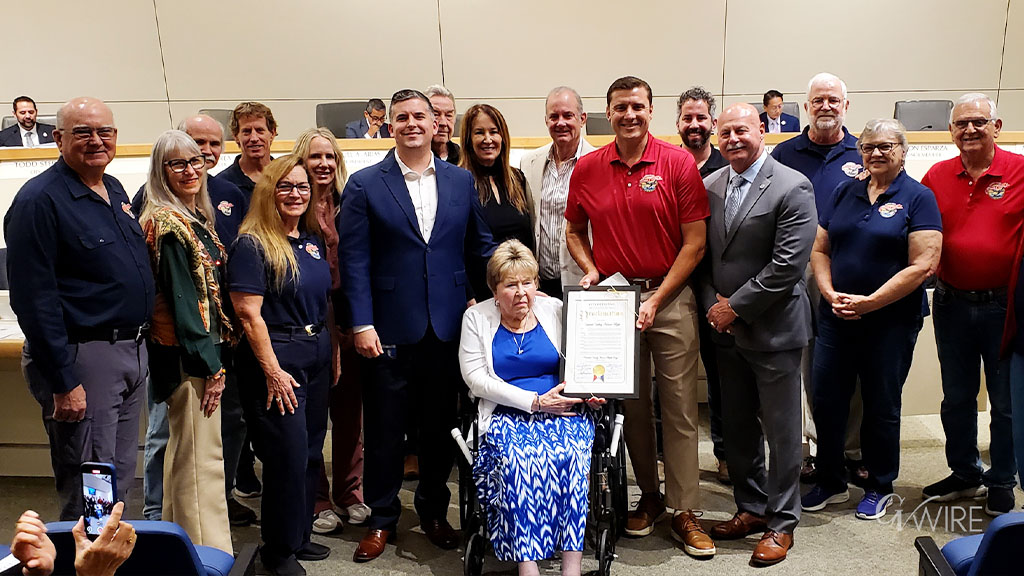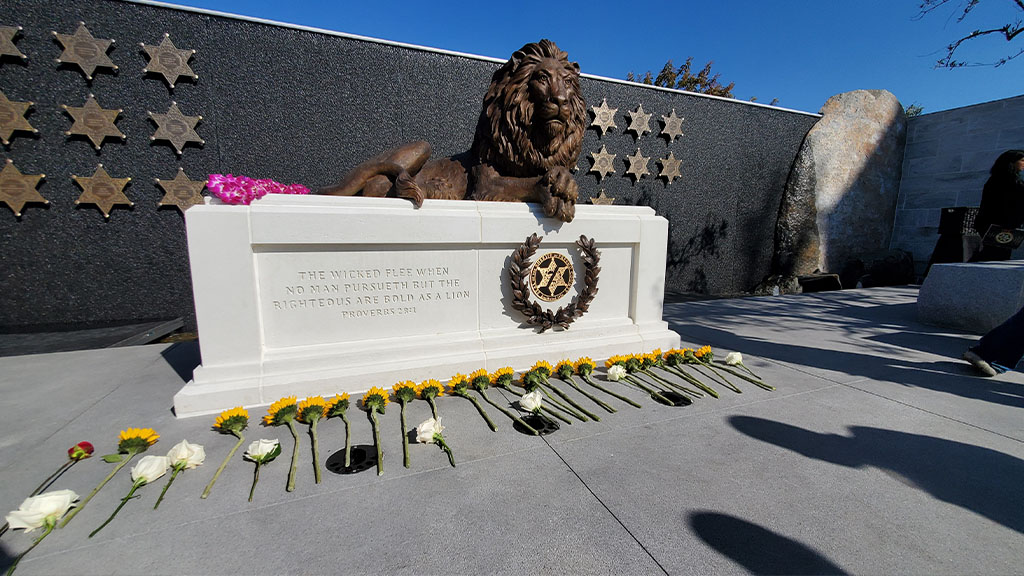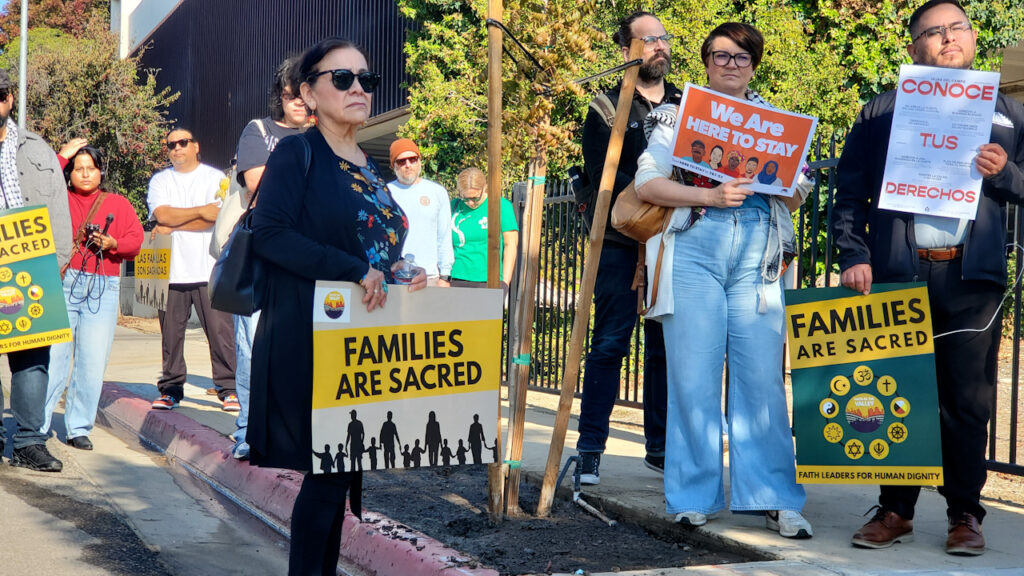Ironworkers assemble a rebar cage for the 2,000-foot Conejo Viaduct that will carry high-speed trains over Conejo Avenue and the BNSF rail line. The viaduct is at Conejo Avenue, between Willow and Peach avenues, west of State Route 43 in Fresno County. (CHSRA)

- Gov. Gavin Newsom wants to extend California’s landmark cap and trade program through 2045.
- But earmarking half of this year’s funds to high-speed rail and CalFire would leave too little for other climate projects, critics say.
- A consequential fight in the Legislature over climate change is expected.
Share
|
Getting your Trinity Audio player ready...
|
This story was originally published by CalMatters. Sign up for their newsletters.
California Gov. Gavin Newsom wants to tap at least $2.5 billion from the state’s climate fund to pay for state firefighting crews and the long-troubled high-speed rail project.
In his budget proposal unveiled last week, Newsom announced that he is seeking to extend the state’s landmark cap-and-trade program, which is funded by credits bought and sold by major polluters, through 2045. But the allocation of the money is already triggering a fervent debate among state lawmakers.
Large polluters, such as oil refineries and power plants, pay for their greenhouse gases through a market system of auctioned credits called cap and trade. Over the past 11 years, almost $13 billion from cap and trade auctions has already been spent on electric vehicles, public transit, clean energy and other projects to reduce greenhouse gases and adapt to climate change.
The governor’s new plan would commit $1.54 billion of the 2025-26 climate funds, and more in later years, to pay for CalFire’s “fire prevention, fire control, and resource management activities.” That would amount to more than a third of the state fire agency’s $4.47 billion budget, according to the governor’s proposed budget. Wildfires have grown more extreme because of climate change, straining CalFire’s resources.
In addition, through 2045, the governor’s plan would earmark at least $1 billion a year of the climate funds to the California high-speed rail project, which aims to connect Los Angeles to San Francisco. The project, which has been beset with construction delays, cost overruns and fights about the route for years, was allocated $407 million of cap and trade money last year.
Combined, the firefighting and high-speed rail costs could consume more than half of the projected $4.8 billion that cap and trade would provide in the next fiscal year.

Consequential Battle Over Climate Change
Newsom’s proposal to extend California’s cap-and-trade program, which expires in 2030, for 15 more years could spark one of the year’s most consequential fights in the Legislature over climate change.
The push to extend the program is bound to be contentious, particularly if Newsom seeks a two-thirds vote of the Legislature, as various groups jostle for a slice of the funding. Watchdogs, policy analysts and environmental justice advocates also have raised concerns about how the program is structured and who benefits the most.
Many legislators have already expressed concerns about the use of climate funds to pay for firefighters and high speed rail. Some lawmakers and other critics and analysts say diverting the money would mean cutting other priorities, such as the transition to electric vehicles.
“You’re going to have some tough choices,” said Helen Kerstein, who tracks the cap-and-trade program for the nonpartisan Legislative Analyst’s Office. “You can’t add $1.5 billion — and growing — and not take anything away, at least in the near term, given current projections.”
“You’re going to have some tough choices. You can’t add $1.5 billion — and growing — and not take anything away, at least in the near term.”
Helen Kerstein, Legislative Analyst’s Office
Funding Diverted From Reducing Emissions?
Assemblymember Lori Wilson, a Democrat from Suisun City, said she is concerned that using climate fund money to pay for CalFire’s activities could crowd out spending that has already been promised to reduce emissions from cars and trucks and fund mass transit.
Transportation “is the largest single source, but the hardest to decarbonize,” Wilson said. “And the whole point is to transition, which is why those investments (are) necessary.”
A coalition of environmental justice groups said the governor, by using so much money for high speed rail and general fund expenses, is leaving inadequate money “for extreme heat impacts, affordable housing, clean drinking water, and other critical environmental programs that reduce greenhouse gasses and clean up contaminated air, water and soil that pose direct threats to public health.”
The cap-and-trade proposal came as California faces a $12 billion budget deficit. By proposing the cap and trade extension as an addition to the budget bill, which moves through the legislative process faster than standalone bills — Newsom could sidestep what might otherwise be a longer, more contentious climate debate.
The move links the reauthorization of the program to broader budget negotiations — boosting the governor’s leverage but reducing legislative oversight and public input.
Assemblymember Cottie Petrie-Norris, a Democrat from Irvine, protested the governor’s moves at a committee meeting on Thursday.
“This is probably the most challenging budget situation the state of California has faced in at least the last 17 years. We are going to be grappling with some very, very tough choices, very tough decisions,” she said. “Trying to then layer in, and shoehorn in, the reauthorization of our landmark climate cap and trade — cap and invest — program seems kind of insane to me.”
Newsom’s proposed extension of the program — which he wants to rename “cap and invest” — comes after President Donald Trump attacked it in an executive order targeting blue-state climate initiatives. The order singled out California’s cap and trade program as forcing businesses to meet “radical requirements.”
Newsom framed his cap-and-trade proposal in the resistance language reminiscent of clashes during the first Trump era. “California won’t bend the knee to a federal administration hellbent on making America polluted again,” Newsom said in a statement.

Lawmakers Question Newsom’s Plan
But some state lawmakers are already questioning key parts of the plan. Assemblymember Steve Bennett, a Democrat from Oxnard, questioned during the hearing Thursday whether revenues from cap and trade could realistically cover all of Newsom’s promises.
“So, in a sense you’re proposing more money than we’re saying we have?” Bennett, chair of the committee, asked Newsom administration officials from the state Department of Finance.
Bennett was also openly skeptical of continuing to use cap and trade money to pay for the high-speed rail project, which has ballooned to a cost of $128 billion. “We need to… make sure we don’t have a train to nowhere,” he said.
Through 2030, 25% of all cap and trade money is earmarked for high speed rail under state law. A bill in the Assembly authored by a Republican that would eliminate that earmark has not moved forward.
“Real tracks are being laid…so I want to get (high speed rail) done. That’s our commitment. That’s why it’s still reflected in the cap and trade extension.”
Gov. Gavin Newsom
Newsom said at his budget briefing Wednesday that his “commitment (to high speed rail) is firm.”
“Real tracks are being laid…so I want to get it done,” Newsom said. “That’s our commitment. That’s why it’s still reflected in the cap and trade extension.”
Several other lawmakers also raised concerns about the governor’s budget math and were skeptical of relying on a funding stream that is supposed to shrink over time as California reduces its carbon emissions.
“Trying to…shoehorn in the reauthorization of our landmark climate cap and trade program (in budget negotiations) seems kind of insane to me.”
Assemblymember Cottie Petrie-Norris
California Transit Association Executive Director Michael Pimentel said the governor’s plan was “silent on the importance of continued climate investment” into mass transit.
“To combat climate change, improve air quality, and address the affordability crisis faced by everyday Californians, state leaders must stand up to protect and maintain continued investment in clean, efficient, and affordable public transit projects and services,” he said.
A Contentious History
California launched its cap-and-trade program in 2013 as a key tool for slashing greenhouse gas emissions. Created under the 2006 Global Warming Solutions Act, the system set a declining cap on emissions from major polluters and allowed businesses to buy and sell permits, creating a market for emissions.
By 2017, then-Gov. Jerry Brown faced a critical inflection point. The program was set to expire in 2020, and Brown sought to extend it through 2030. But the path to reauthorization was anything but smooth.
The political lift came in securing a two-thirds vote in the Legislature, the threshold that would help inoculate the program from legal attacks, given that California voters expanded the definition of a tax in 2010.
That supermajority required bipartisan support, and Brown courted moderate Republicans with concessions: tax breaks for manufacturers, fee waivers for rural residents and spending assurances.
Newsom’s proposal would maintain many of the program’s most controversial provisions. Those include free emission permits for the oil and gas industry, a price ceiling mechanism and the use of carbon offsets, which have drawn criticism over concerns about their effectiveness. The governor’s proposal leaves most of the details up to the discretion of the Air Resources Board, which oversees the cap and trade program.
One key issue is the number of free allowances to industry, including the oil and gas industry. Newsom’s proposal could extend many of those giveaways through 2045, said climate expert Danny Cullenward, vice chair of an independent advisory cap and trade committee.
Cullenward told CalMatters that the market will likely begin shifting from a surplus of pollution permits to a scarcity. That will raise emissions reductions and state revenue, but also potentially increase consumer costs, with key decisions left to the Air Resources Board.
“It’ll bring in more money to the state, but it’ll also have higher consumer price impacts,” Cullenward said. “That’s going to be a key issue.”
The cap and trade debate is unfolding amid growing concern over affordability in California — a theme running through nearly every aspect of the state’s climate policy. A new report from the Legislative Analyst’s Office raised questions about how much the program could cost Californians. For instance, the cap and trade program could add 74 cents to the cost of gasoline if credits rise to their highest levels, amounting to about an additional $700 a year for the average California household, the report said.
Of the $12.8 billion spent so far, nearly $9.2 billion has been invested in projects that benefit disadvantaged communities that are designated as a priority, according to the air board.
The cap and trade debate is unfolding amid growing concern over affordability in California — a theme running through nearly every aspect of the state’s climate policy.
But environmental justice advocates have long criticized the program for failing to reduce local pollution in those communities, which often bear the cost of higher gasoline prices, too. Because cap and trade allows companies to comply with greenhouse gas limits by buying credits, they can continue operating in low-income neighborhoods without reducing emissions there.
Advocacy groups have asked the Legislature to reject a plan similar to the governor’s that would largely leave the program unchanged.
“Our communities, who bear the disproportionate burden of some of the worst air quality in the state, and the nation, are also predominantly communities of color,” Connie Cho, senior policy advisor for the Asian Pacific Environmental Network, said at a state Senate hearing earlier this month.
“We believe it is not only possible, but absolutely necessary, to achieve and balance all three: climate, health equity and affordability through the cap and trade program as the cost of living rises to a fever pitch.”
This article was originally published on CalMatters and was republished under the Creative Commons Attribution-NonCommercial-NoDerivatives license.
RELATED TOPICS:
Categories

Fresno Launching Neighborhood Repaving Project Monday








